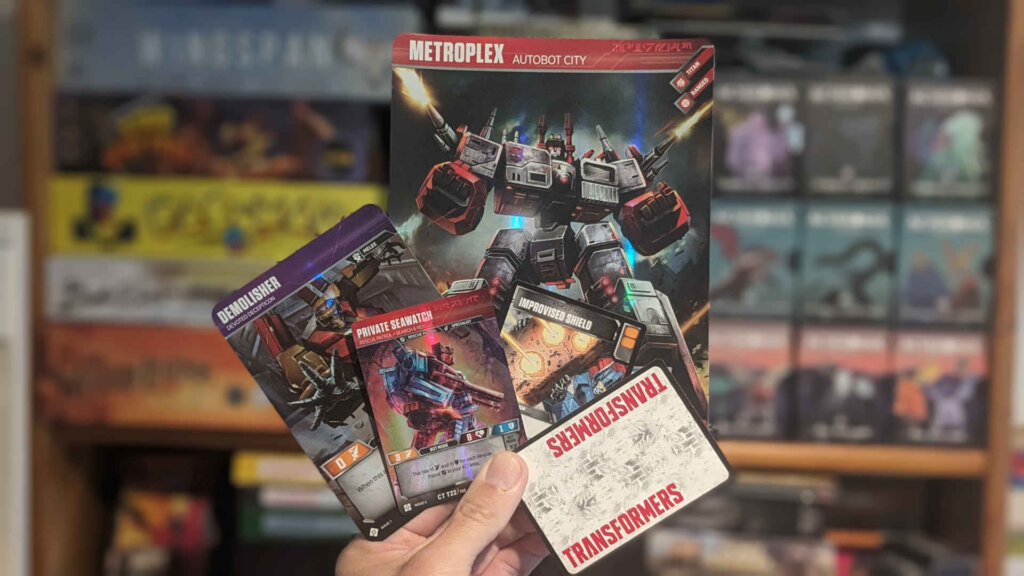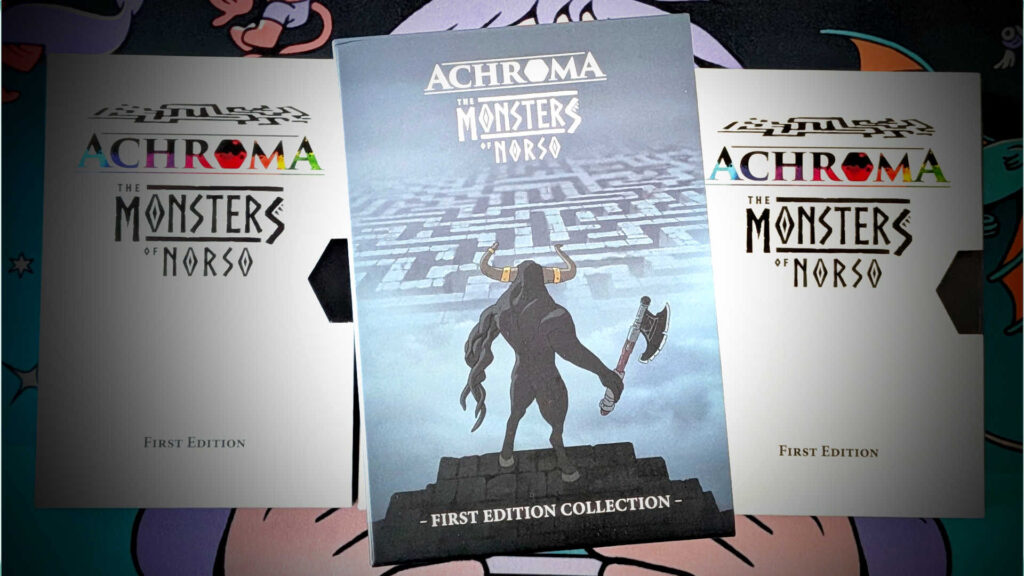The Transformers celebrate their 40th anniversary in 2024, having launched in the West way back in 1984.
There’s a new Transformers animated movie on the way too: Transformers One, covering the origins of the main characters before they were Autobots and Decepticons; so, as a fan of the robots in disguise from the very beginning, I thought it was the perfect time to check out the Transformers CCG, which was released by Wizards of the Coast back in 2018.
Table of Contents
ToggleA Brief History Of Transformers
For the uninitiated, or if you simply need a refresher on the lore, the Transformers series, at its core, is about two races of warring robots, the Autobots and Decepticons, locked in an endless struggle for power on their planet, Cybertron.
Though the reasons for their eternal war and the nuances of good and bad on either side have deepened and evolved over the years, as well as the reasons for them leaving Cybertron and coming to Earth, the basis has generally remained the same.
What’s unique about the Transformers, as you can probably guess, is that they can change into different vehicles or objects; usually, Autobots are ground vehicles such as cars and trucks, whereas lots of Decepticons transform into jet fighters, tanks or other vehicles more known for their military use.
That’s not a hard and fast rule, of course, and there are plenty of robots on either side that transform into different objects (leader of the Decepticons, Megatron, being a good example; he could transform into a functioning pistol).
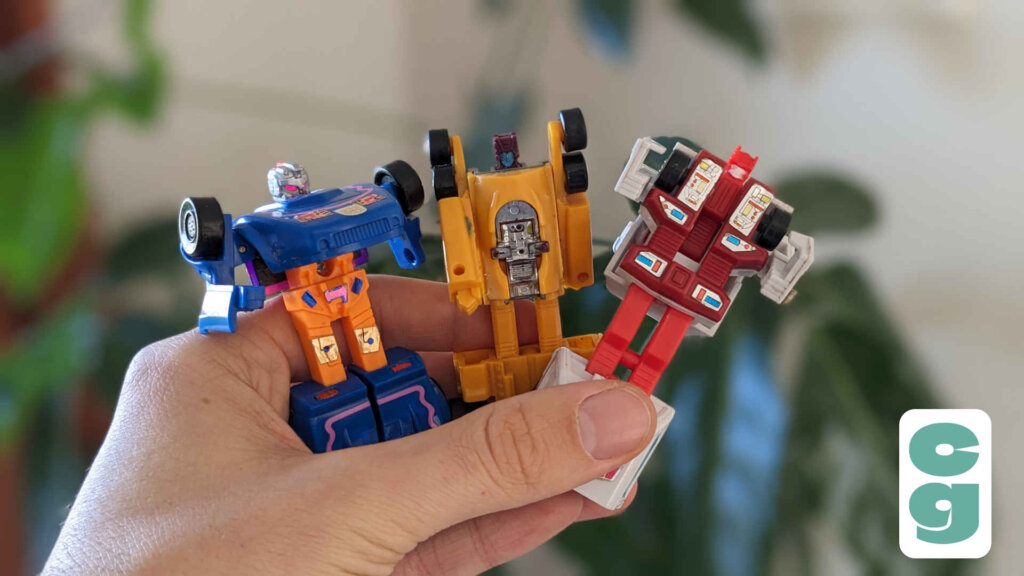
Though they were introduced to the West via the toys and in their well loved, but sometimes (unfairly) dismissed as little more than a toy advert, Transformers animated series back in 1984, the origins of the Transformers lay in several different Japanese toy lines, which were all brought together into the same product range when they headed beyond their country of origin.
Character names that we know and love, as well as much of the lore behind the toys and the show, came from Marvel Comics; much of the detail was from writer Bob Budiansky, who wrote the majority of the comic book series; pretty much all of the first generation, known to fans as G1, of character names and personalities were Budiansky’s.
The animated Transformers movie in 1986 was intended as a way to sell the second range of toys to kids; as such, it presents an unprecedented number of major character deaths on screen, with an entire generation of children scarred by Optimus Prime’s heartbreaking demise in the first act of the film.
Following the death of many popular characters, the second generation of toys didn’t quite hit the mark and after numerous relaunches and reboots over the years, the Transformers took quite some time to really make their mark on popular culture once more.
Michael Bay’s live action Transformers movies kicked off with a reasonably well received first entry in 2007, but became ever more divisive and critically reviled (though still hugely commercially successful) until his last entry, 2017’s Transformers: The Last Knight.
Travis Knight’s 80s set Bumblebee movie righted the ship somewhat, and 2023’s Transformers: Rise of the Beasts, while it didn’t set the world on fire either critically or commercially, was seen as a moderate success in the eyes of Transformers fans.
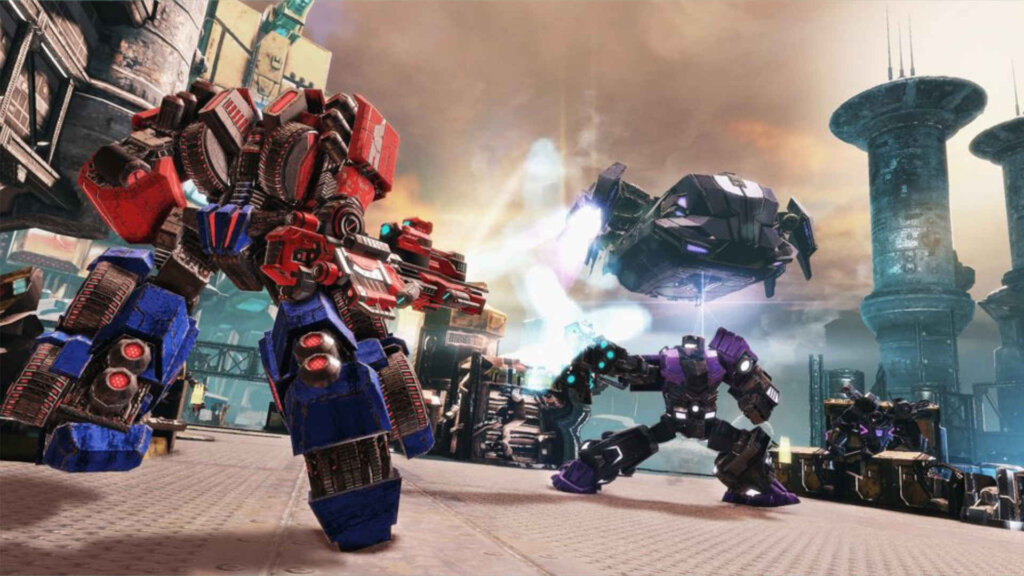
While the cartoons and live action movies seemed to keep the franchise moving for TV and movie audiences over the years, High Moon Studios worked on a pair of stunning third person shooters that brought numerous G1 characters, storylines and references to life, starting with War for Cybertron in 2010 and the peerless Fall of Cybertron in 2012.
Transformers video games had been hit or miss, mostly miss, before and since then, but these two games (particularly 2012 title Fall of Cybertron, pictured above) really hit the mark.
They provided Autobot and Decepticon designs that felt modern yet also respectful to the way that the G1 characters looked; in stark contrast to the Transformers of the Michael Bay movies (often derisively known as ‘Bayformers’), which almost all looked generic, boring and too beholden to lucrative deals with specific car manufacturers.
It’s the War for Cybertron and Fall of Cybertron designs that seem to have provided much of the inspiration for the aesthetic of the Wizards of the Coast Transformers Trading Card Game, the first set of which was released in 2018.
What Was Unique About The Transformers Trading Card Game?

The box sets for the Transformers Trading Card Game were always very striking, with the oversized character cards fully on display, on both sides, in the transparent, plastic packaging.
Unlike the oversized cards you get in, say, Pokemon, the various sizes of larger character cards that were part of the Transformers Trading Card Game were fully playable in game.
Though the majority of the cards that were played during the game were from a deck of standard sized cards, which you’d put together according to the game’s deck building rules, much as you would in games such as Magic: The Gathering or Pokemon.
Another stand out feature of the Transformers character cards was the fact that they were double-sided, reflecting the fact that your characters could, yes, transform.
Each character had, just like its counterpart in Transformers lore, an alt-mode; so Bumblebee could change into a car, Skywarp into a plane and so on.
As the game’s expansions were released, this ambitious concept became even more so, with Combiners able to create massive threats from putting together multiple characters or even triple changers, who had three forms.

You might wonder how on Earth (or, perhaps more appropriately, how on Cybertron) the game could possibly handle triple changing robots, or robots with two different modes plus the ability to become part of a larger Combiner Transformer, but the designers cleverly approached this with ‘three sided cards’.

Though it’s not quite as magical as it sounds, this meant a card that was essentially folded, with two sides for two different forms, which then opened up to become its third and final alt-mode.
In the image above, the two pictures on the left show the two different ‘sides’ of the folded Dead End card. Then, on the right, the unfolded card, which you would then turn over to become part of Menasor!
That’s right; all of those images above show a single card!
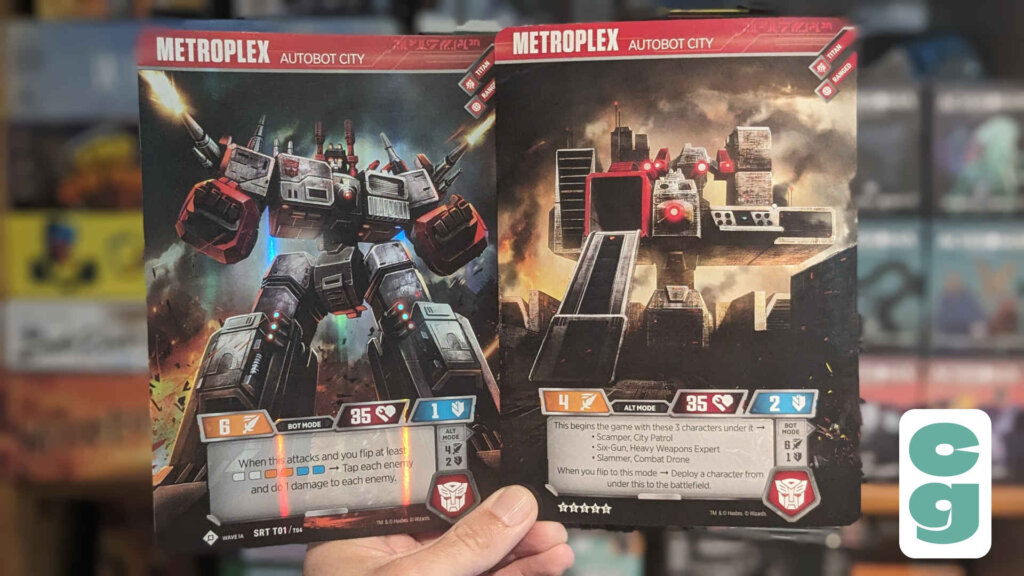
Even enormous Transformers such as Metroplex, the Autobot City, got a look in, with absolutely giant cards, even in comparison to the oversized character cards that featured in the game’s usual booster packs.
From a visual standpoint, not to mention from the point of view of Transformers fans who had immersed themselves in the lore for decades, the Transformers Trading Card Game was an absolute dream come true.
It’s hard to think of an adaptation from screen (and page) to tabletop that has been done with the care, attention and adherence to lore in such a smart, faithful way as Wizards of the Coast did with the Transformers Trading Card Game.
Yet unfortunately, it wasn’t to last.
Why Did The Transformers TCG Die?
After just five set releases, the Transformers Trading Card came to an end, with Wizards of the Coast announcing, as part of an official statement, on July 20th, 2020: “While the retailer and player community continued to grow, our product offerings didn’t meet the expectations of the broader fan base to engage further with the brand”.
In less corporate speak, what Wizards were getting at with that statement is that, though the game found itself a dedicated fanbase, it wasn’t enough to sustain the game any longer.
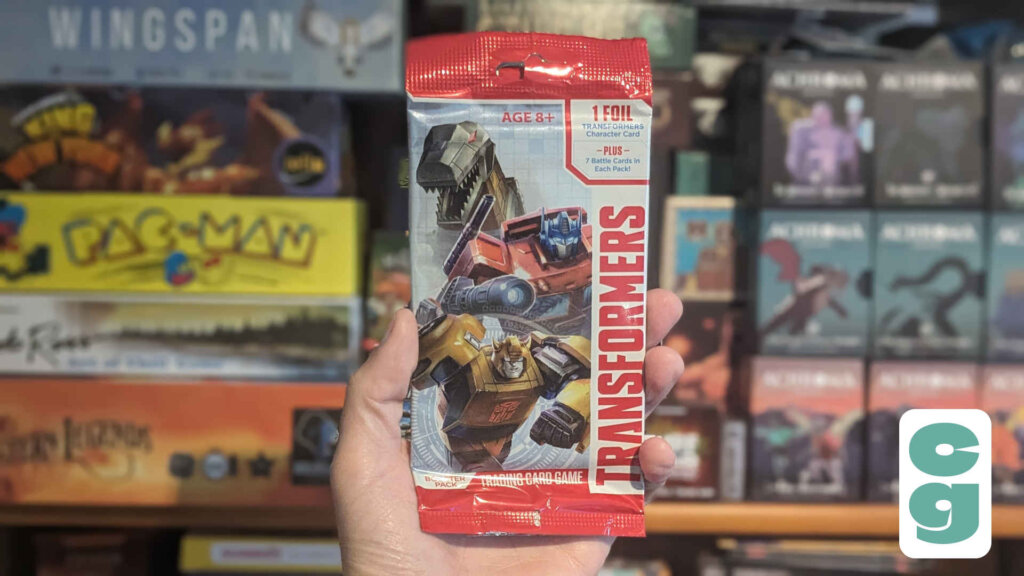
Given the unique nature of the cards and mechanics, that’s perhaps unsurprising; producing larger, foil treated cards and physically oversized booster packs, with more and more elaborate ways of recreating ever more obscure Cybertronian warriors, can’t have been cheap, and there must have been a need to find a much wider audience, or at least a player base that was able to invest a lot more in the game than they had been at that stage.
It’s a huge shame, because the Transformers Trading Card Game brought a unique experience to the tabletop. The game’s visuals and mechanics, not to mention the breadth of characters and storylines it covered, provided absolutely top tier fan service, not to mention an experience, for players of all ages and skill levels, that felt as if it was still growing when it was unceremoniously cut short.
So with all of that in mind, let’s take a closer look at the Transformers Trading Card Game.
Where To Start With The Transformers Trading Card Game?
The initial releases for the Transformers Trading Card Game were pretty straightforward, consisting of a single pre-constructed deck set, a two player set and booster packs.
Despite this, the aforementioned packaging for the sets was eye-catching and immediately appealing, with the oversized character cards on full display, the transparent plastic allowing interested fans to turn over the boxes and check out both sides of the oversized, ‘transforming’ cards.
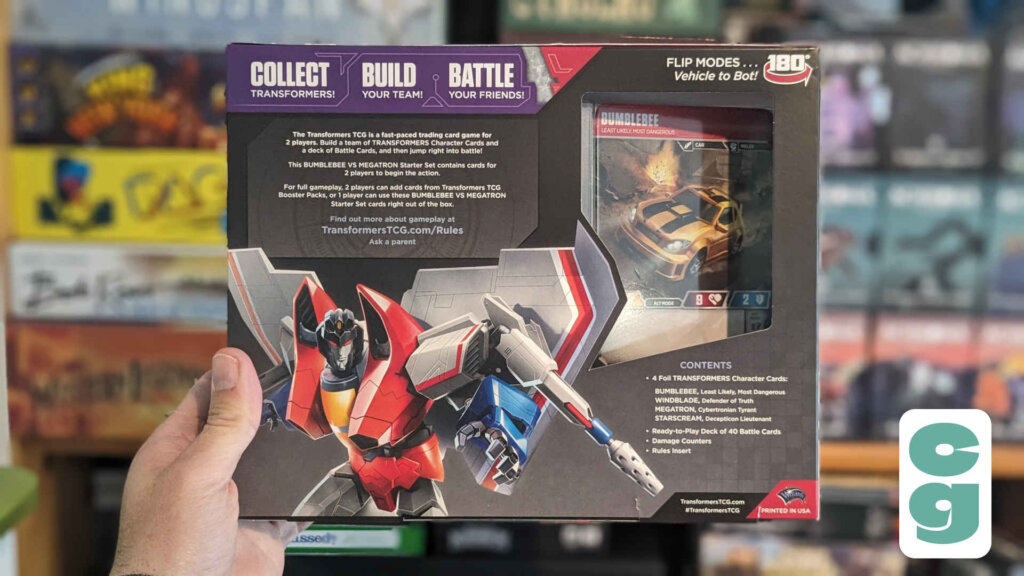
Even the booster packs were striking, mostly due to their size, as each one contained one of the double-sized character cards along with a selection of standard-sized cards.
Of course, the best place to start at launch would have been with one of the starter sets, but which one you chose would have depended on whether or not you had friends who were also interested in getting their own sets.
The Autobots Starter Set featured Bumblebee as its main character card; a very smart choice at the time, given that the Bumblebee movie was imminent.
As an aside, it certainly didn’t hurt that the Bumblebee film was excellent; was it coincidental that the film also opened with a Cybertron-set battle sequence that used Autobot and Decepticon designs that hewed very closely to G1 aesthetics, giving them a very War for Cybertron-style spin?
In any case, the fact that the aesthetics of both game and film adaptation were aligned, and used the far more popular and enduring Transformers designs, was immediately a point in the Trading Card Game’s favour.
It’s perfectly possible to pick up a reasonably priced, two player starter set these days; our recommendation would be to go for the Bumblebee vs Megatron set as a good starting point to learn and play. Note that, to play the full Advanced game, you’ll still need to buy some extra boosters for more characters.
How Do You Play The Transformers Trading Card Game?
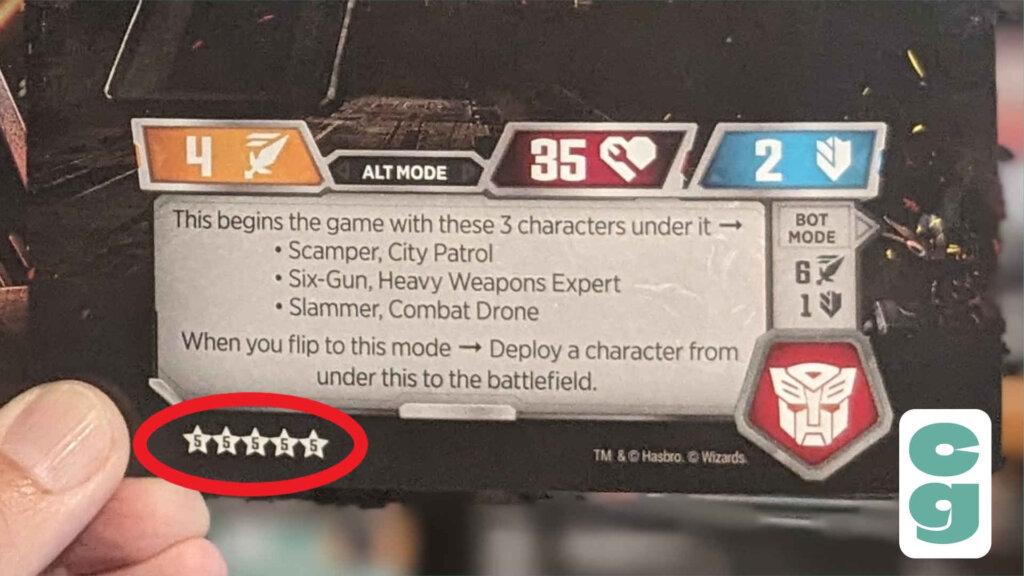
So, in the card game, players build a team of Transformers using the star point values on each card. In the image above, we’ve circled the points shown on the Metroplex card; this single Transformer alone is worth 25 stars (though as you can see from the text above the stars, it does start with a team underneath the card!).
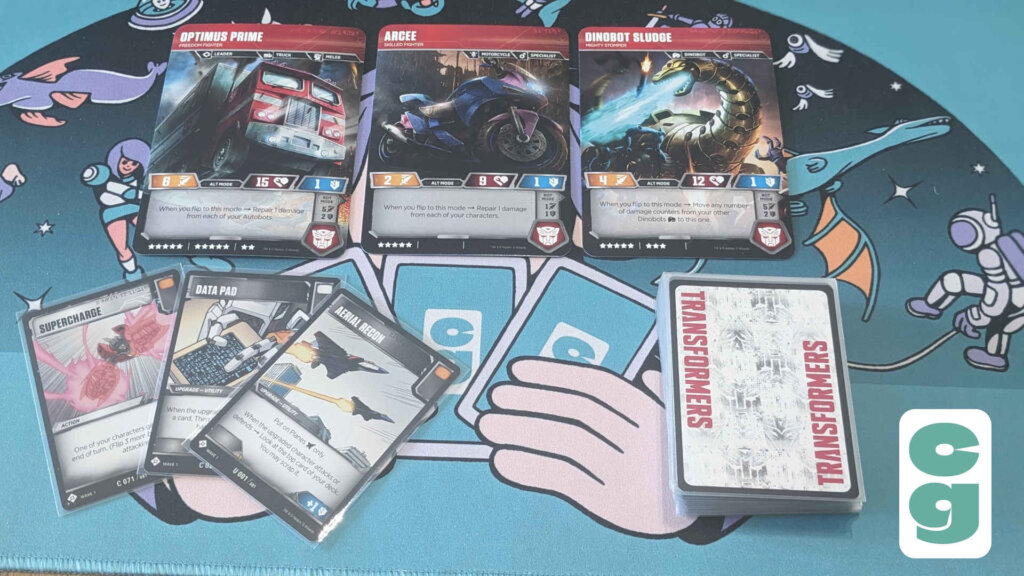
No faction, side or specific Transformer is restricted, as long as players build a team of Transformers whose star values add up to 25 stars or less, and without using duplicates of uniquely named Transformers. An example of a 25 star team is shown above, at the beginning of a game.
There are often variations of the same character; it’s ok to use these if their full name differs. So you can have Optimus Prime: Battlefield Legend and Optimus Prime: Gleaming Commander as part of your lineup, for example.

Each player’s Transformers start in their alt-mode; note that each Transformer’s mode has different stats and abilities, as we’ve circled above on each of the Private Sidetrack card’s two sides.
Here’s something that’s very interesting too: the rules have both Basic and Advanced variations.
Though Basic is an obvious starting point for very young fans, Advanced is what we’ll focus on, as even the youngest or least experienced of gamers will likely get bored of the incredibly simple gameplay in the Basic mode.
Even Advanced is far from difficult to play, and is not a great deal deeper than the Basic rules, so it is somewhat baffling that Wizards of the Coast opted for two versions of the rules for the Transformers Trading Card Game (and only included Basic Rules in the initial starter sets!).
Getting Started
In any case, players use a deck of battle cards, with a 40 card minimum, which will contain cards such as Actions and Upgrades. No more than three copies of a named card can be included in a deck; most sets do come with pre-constructed decks, and they’re a good place to get started with learning and playing your initial games.
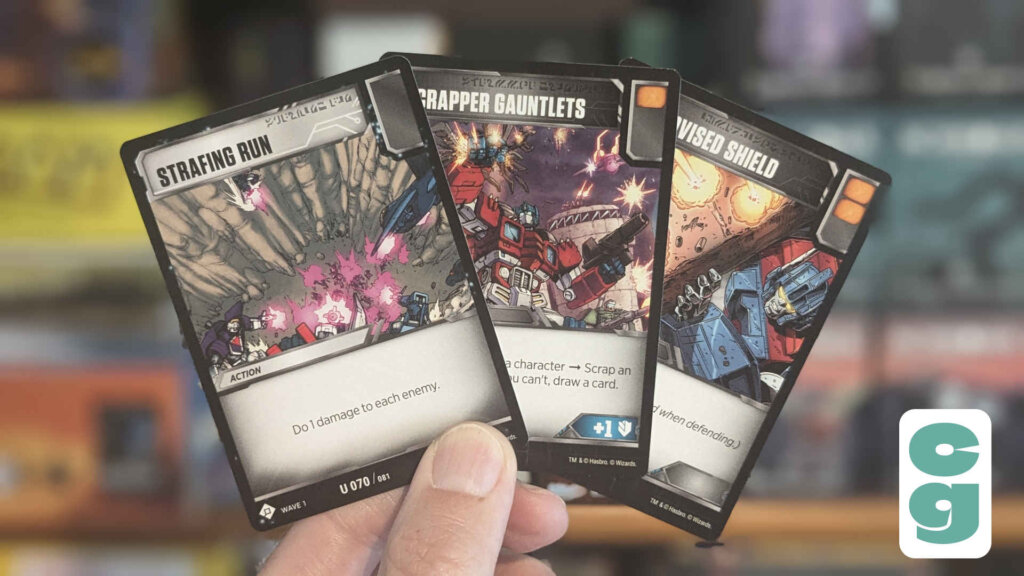
Each player draws three battle cards, then they choose a random starting player (note that the first player, on their first turn, can’t play Actions or Upgrades, and the second player can only play 1 Action or Upgrade on their first turn, not both).
The Turn Order
A player’s turn then consists of the following steps, in any order, once they’ve drawn a battle card:
- You may flip one character to a different mode.
- You may also play one action card from your hand.
- You may play one Upgrade card from your hand to a Transformer; note that some Upgrades are restricted to being used by Transformers with certain keywords, and that Transformers can only have one of each type of Upgrade attached, with the types being: Weapon, Armor or Utility.
Combat

Once those steps have been taken, it’s time to move on to what feels like the core of the game, and what everything else is truly based around: the combat phase.
The active player chooses one of their untapped characters (that is, a vertically oriented Transformer card) to attack, then chooses a defender to take on and taps their attacking character.
Just like in games such as Disney Lorcana (which of course, Transformers precedes by several years), the attacker must choose a tapped defender; however, there’s a rule in Transformers that if no defending characters are tapped, then anyone on the opposite side can be attacked.
In the image above, the player with the Raider Hyperdrive card needs to choose a target on the Autobot side; as Dinobot Sludge is the only tapped character, they must engage in combat with that character.
Combat is handled somewhat differently to the way it progresses in other games; once the attacker and defender are chosen, each player turns over the top two cards of their deck, with the coloured icons on the top right of each revealed card being counted; check out the icons as they appear on the card, so you can easily identify them.
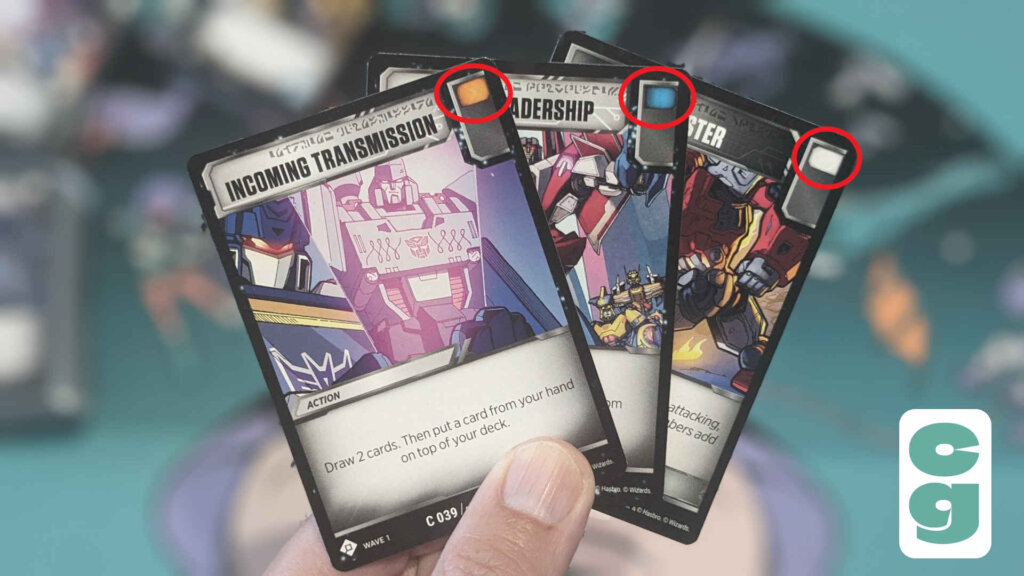
If an attacking character has the Bold keyword, they can reveal one more card. If the defender has Tough, they can reveal an extra card.
If either player reveals white icons, they can reveal two more cards as a bonus (this applies only once per attack, so if any further white icons are revealed, the bonus does not trigger again; note also that further coloured icons did appear in the last few sets, but if you’re playing with starter sets, you’re not likely to encounter these immediately).
Then, the attacker counts all of the orange icons they revealed, adding the total to the Attack value on the current Attack value of their character card.
The defender counts the blue icons they turned over, adding this number total to their own Defense.
If the attacker’s total Attack is higher than the defender’s total Defense value, damage is dealt to the defender, equal to the difference between the two values. If the Defense is equal to or exceeds the total Attack, no damage is done.
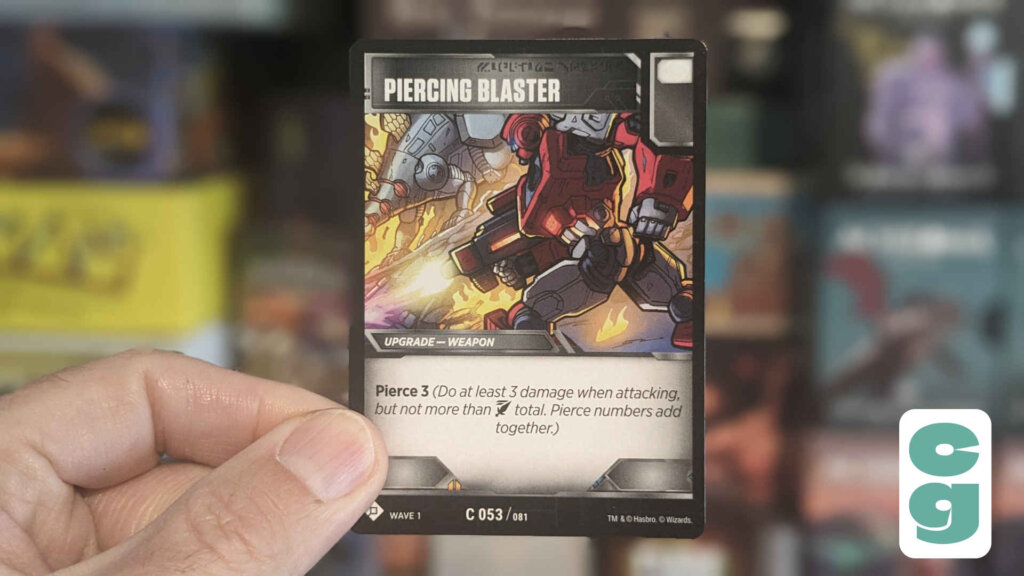
The Pierce keyword allows an attacker to deal guaranteed damage, even if the Defender successfully negated all damage. For example, if an attacker had an attack total of at least 3, if they have Pierce 3, that 3 damage would be dealt even if the damage was completely negated by the defense total (see the Piercing Blaster card in the image above as an example of an Upgrade that gives Pierce to the Transformer it’s attached to).
This only applies if the attacker has an attack total of the Pierce number or more, however.
The defending player places damage counters on their Transformer equal to the damage; if they have damage equal to or exceeding their health, they’re knocked out and removed from the game.
Continuing Your Turn
If your opponent has any untapped characters, your turn is over once your attack is completed.
If your opponent has no untapped characters, however, you can continue attacking until all of your characters are tapped!
Once all characters on both sides are tapped and attacks have been completed, all characters are untapped, with the next player beginning their turn.
If a player’s deck ever runs out of cards, the discard pile (known as the scrap pile, in Transformers TCG terminology) is shuffled to create a new draw deck.
Our Verdict On The Transformers TCG
As you can probably tell from our rules summary above, the Transformers TCG is very fast paced and highly focused on combat, in a way that other games are not.
For example, even though games such as Magic: The Gathering and Pokemon heavily feature combat as a central mechanism, they do feel as though they have a much more nuanced and layered experience, of which combat is merely one element, even though it’s generally the path to victory; in Transformers, it does feel as it combat is almost the entirety of the experience.
This does feel appropriate to the action-packed nature of Transformers, however.
The slight randomness of drawing icons to determine the result of combat adds a bit of unpredictability to any combat round; though this almost chaotic element is something that players of other games may not have found appealing, it does a great job of simulating the way that sometimes, in Transformers, a plucky underdog or lesser powered character may unexpectedly get the upper hand.
The card design is fantastic, and the options for building your own army of Transformers, with some genuinely brilliant and thematic touches, such as Autobot City Metroplex deploying characters from inside himself, help to make this an absolutely superb game for Transformers fans.
Booster packs, with a guaranteed, oversized character card, were always striking to look at and initially at least, exciting to open; likewise, subsequent sets featuring Combiners or the aforementioned Metroplex, his support characters and custom deck, were always beautifully designed and, again, highly thematic.

Sticking with the subject of booster packs, it is unfortunate that, with the Rise of the Combiners set, you could sometimes receive a character that wasn’t able to fully transform, as its alt mode needed one or more other characters to function. This made opening boosters in the later sets a little frustrating at times; you could find a character card that was Rare, and only usable with a specific, second Rare character card (see the image above for an example of that!).
The same was true of the bigger Combiner characters; trying to find every single character in order to make the bigger Transformers could be a real chore.
It’s also unfortunate that the gameplay is a little shallow, too; at times, it does feel as if the Transformers TCG is an exercise in style over substance, with cards that can, particularly with Combiner and Triple Changer cards, feel a little gimmicky (it was, however, undoubtedly cool to find characters that could flip to become equipment upgrades on other Transformers).
That’s not to say that depth doesn’t exist, or that no effort was made in the design of the game (ensuring you had enough orange and blue icons on cards in your deck added a neat, unique extra layer to deck building, for example) it’s just that, in comparison to other games, perhaps if only due to their longevity, it does fall short somewhat.
Having just Basic rules in the original starter sets didn’t help matters at all; forcing players to hunt for the Advanced rules online, making the game seem even shallower to the average person when they got their first cards, feels like a big misstep that would have been difficult for the game to recover from.
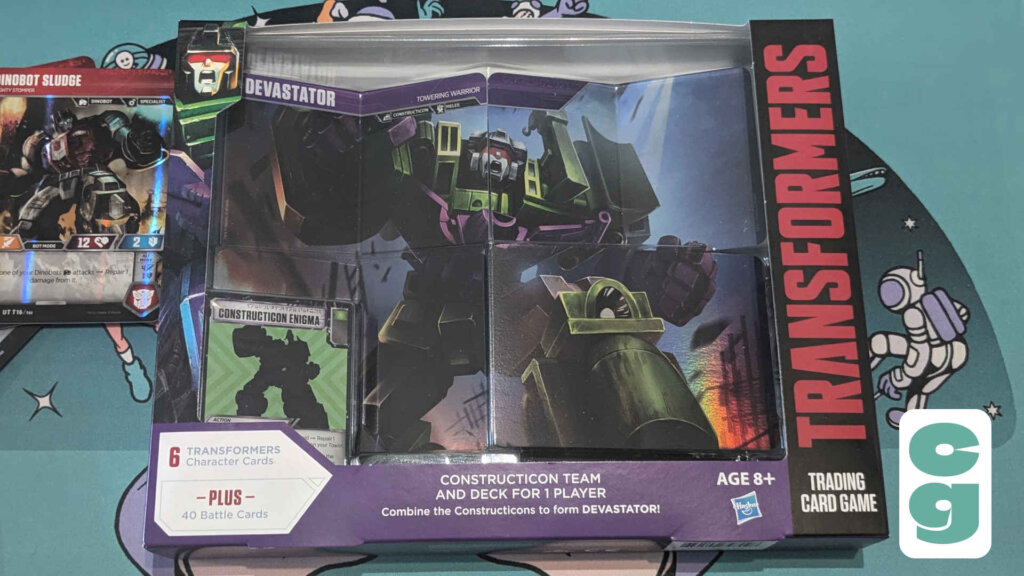
These days, despite how recently the Transformers TCG was released and discontinued, the game seems largely forgotten and rarely spoken of. Aside from the rarest of cards, they’re easy to find and cheap to buy, with starter sets in particular being available, sealed, at ridiculously low prices.
If you’re a Transformers fan, I’d definitely recommend that you check out the game with a few different Starter sets; if you’re willing to throw yourself in at the deep end a bit with slightly more complex Transformers and battle cards, the absolute best two player set is Blaster vs Soundwave: 35th Anniversary Edition.
For the non-fan, the Transformers TCG doesn’t have the solid backbone of a game such as the more recently released Disney Lorcana or Star Wars Unlimited, for a few examples. With no further support and new sets no longer being produced, with little in the way of a community still playing the game, it’s even harder to recommend.
It’s a shame, but it feels as if the Transformers TCG was a little too early, and, released today, it could have been there to ride the current wave of Trading Card Game hype. If it had emerged alongside those aforementioned newcomers such as Disney Lorcana or Star Wars Unlimited, the aesthetically striking Transformers game may well have found itself a wider audience.
Though the Transformers themselves have endured for four decades, unfortunately the card game didn’t get the chance to truly flourish, and ended up being cut down in its prime.


